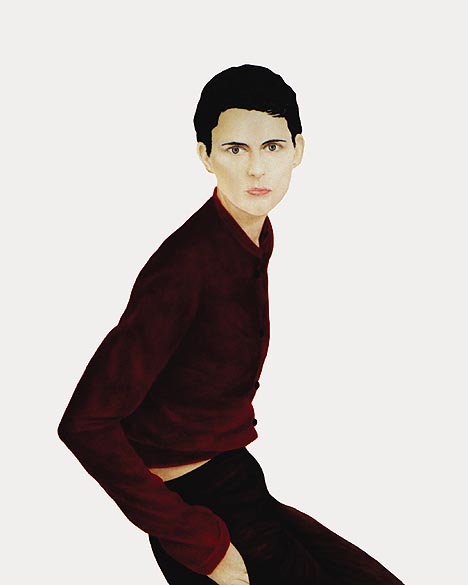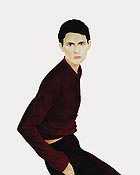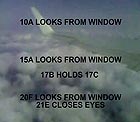
translated and summarized by: Liz Wollner-Grandville,
English summary May 31 - June 4
Museum der Moderne Salzburg Rupertinum
Bertram Hasenauer - Sulur, Paintings and Drawings
15.05.10 - 18.07.10
Appear and disappear
La vérité a un visage d'homme. [Albert Camus].
In the Greek mythology, Promotheus, the Creator God formed androgynous humans out of clay and Goddess Athena breathed wisdom and knowledge into them. Betram Hasenauer’s portraits appear like figures transferred from the ancient world to today, ageless and disconnected from time. They insinuate something that is not (no longer) visible. Their skin radiates eternal adolescence, their faces are flawless, and they unfold against a neutral background, as if peeled out of time. They have no memory and their glance is not directed towards anything in particular.
Especially the eyes present the spatial as well as timely ambivalence of the paintings; their facelessness embodies both the beginning and the end. No matter if their glance is directed ahead, towards the viewer, or away from him, towards the back, it always seems to gaze into space. Reality oscillates between past and future. The figures remain in a (self) reflective poise, open eyed, but simultaneously withdrawn. Their faces are characterized by mysteriousness, underlined by captions respectively commentaries. Still hanging on to what may be.
“The world is constituted in such a way that things appear and disappear. … Not reality constitutes the opposite of appearance, but its disappearance”, John Dewey stated in an essay in 1927 (Reality and Appearance). By holding on to the moment its disappearance is already included. You somehow slip away. The expression of meditative indifference in the faces creates a distance, which evades all usurpation. Man is a “figure of distance” (Heidegger, Vom Wesen des Grundes).
Who are those depicted on the paintings? What do they refer to? What is the idea behind a portrait? The Greek work idea means “appearance” and derivates from ideio – to see, recognize. For Plato, ideas are archetypes and concrete appearances. They do not change; they are immortal and identical with themselves.
Bertram Hasenauer mistrusts a rigid terminology as well as the attempt to capture time or appearances on canvas. He is not interested in the depiction of reality or in forming pure ideas (abstraction). Art has its own reality and is reality in itself. It has its own effect, its mysteriousness. If one is tempted to solve its mystery, it dissolves.
Hasenauer’s figures gaze at us and pull away from our glance. We do not read their face. The paintings store and reflect the perceptions of the viewer and at the same time throw the viewer back towards his own perceptions.
By Elvira Gross
Museum der Moderne Salzburg Rupertinum
5010 Salzburg, Wiener Philharmonikergasse 9
www.rupertinum.at
Galerie Raum mit Licht
Rini Tandon – To Spaces Unsigned
29.04.10 – 04.06.10
Desire for information, dissolving fragmentations
How should a demanding exhibition be designed, which – on the basis of contextual art - includes scientific methods as well as contemporary forms of art?
Rini Tandon employs research results, analyses and documentations
to evaluate specific spatial concepts. The artist, who was born in India and lives in Vienna since 1978, differentiates between absolute and abstract space. During the past 10 years, her interdisciplinary selection of topics generated a transparency of data, which aimed at inspiring an open dialogue.
The installation positioned close to the gallery entrance looks like tangled gymnastics equipment. Some parts are accentuated by blue nylon strings and resemble dynamic fault lines, which have escaped (human) control.
At a first glance, the “Transducer” drawings, created with a white pen on black paper, appear like virtual computer simulations. Depending on the viewpoint, one seems to either identify full circles or three-dimensional objects. Tandon investigated inter-medial relationships between painting and sculpturing in a work series (which is not displayed at this exhibition) and which originated in the late nineties. For more than two decades, the artist mainly focused her work on researching and implementing the underlying themes of presence/absence and visibility/invisibility.
The meticulously created exhibition project “To Spaces Unsigned” offers extensive insights into Rini Tandon’s uncompromising reflections.
By Leon Gumil Hainzl
Galerie Raum mit Licht
1070 Vienna, Kaiserstrasse 32
CharimGalerie
curated by_Valie Export: Mrs Roberts is Gonna Be Late
06.05.10 – 05.06.10
Lump in one’s throat
At first everything seems peaceful and normal and even a bit boring on the airplane. From the window one can see clouds and the airplane’s wings. What each individual passenger does is succinctly noted on the photo: “15A sleeps” or “17D reads”. It all seems like a nice idea, and only after a while does the awful story unfold and it becomes clear that this is the narration of an airplane crash; testimonies of tenderness (“18B strokes 18C”) turn out to be farewells for good. The video “Fly” by Tomás Svoboda leaves a lump in one’s throat as does his installation “Home video Phuket, Thailand, December 2004” – the staged beach idyll shows the moment before the Tsunami strikes and kills hundreds of thousands of people.
Svoboda’s works should, as the accompanying text of the exhibition “Mrs. Roberts is Gonna Be Late” claims, aim at translating “our film-like perception; the vision mediated by film and which has become our habitual form of perception”. But this does not really apply to Svoboda’s works – his work is based on images transported through the media and TV - and that constitutes a significant difference. In contrast, the works displayed by Daniel Pitín’s deal with film: his bleak paintings refer to famous film scenes. The video “Dinner with Malevich”, which was especially created for this exhibition, shows Malevich’s famous black square copied into a Czech film from the sixties. A sequence of enigmatic scenes develops in which this icon of Modernism is constantly repositioned in a bourgeois living room.
“Mrs. Robinson is Gonna Be Late” is part of the “curated by”-series, in which 20 galleries invited artists to curate an exhibition. Valie Export selected these two participants - of which one has a foible for old films and the other for mass media – but what these two artists have in common remains a mystery.
By Nina Schedlmayer
CharimGalerie
1010 Vienna, Dorotheergasse 12
www.charimgalerie.at
Mehr Texte von translated and summarized by: Liz Wollner-Grandville


 Teilen
Teilen




